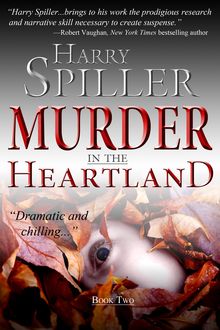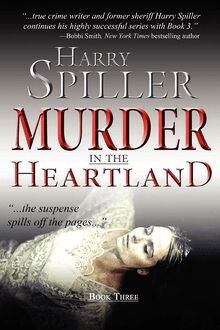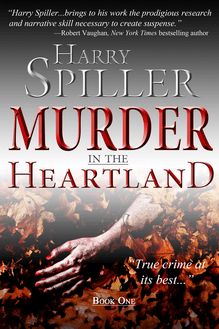Murder in the Heartland: Book One , livre ebook
122
pages
English
Ebooks
2011
Vous pourrez modifier la taille du texte de cet ouvrage
Obtenez un accès à la bibliothèque pour le consulter en ligne En savoir plus
Découvre YouScribe en t'inscrivant gratuitement
Découvre YouScribe en t'inscrivant gratuitement
122
pages
English
Ebooks
2011
Vous pourrez modifier la taille du texte de cet ouvrage
Obtenez un accès à la bibliothèque pour le consulter en ligne En savoir plus
Publié par
Date de parution
01 octobre 2011
Nombre de lectures
1
EAN13
9781596529649
Langue
English
Poids de l'ouvrage
1 Mo
Publié par
Date de parution
01 octobre 2011
Nombre de lectures
1
EAN13
9781596529649
Langue
English
Poids de l'ouvrage
1 Mo
H ARRY S PILLER
MURDER IN THE H EARTLAN D
Book One
To Kathy Jo
Trade Paper Press
An imprint of Turner Publishing Company
4507 Charlotte Avenue, Suite 100
Nashville, TN 37209
Phone: (615) 255-2665 Fax: (615) 255-5081
www .turnerbookstore .com
Murder in the Heartland, Book 1
Copyright © 2010 Harry Spiller
All Rights Reserved. This book or any part thereof may not be reproduced without the written consent of the author and the publisher.
Library of Congress Control No. 2003095194
ISBN: 978-1-59652-797-3
Printed in the United States of America
10 11 12 13 14 15 16 17—0 9 8 7 6 5 4 3 2
Contents A CKNOWLEDGMENTS P ROLOGUE S ERIAL M URDERER J OHN P AUL P HILLIPS (C ARBONDALE , IL) T HE D EADLY N IGHT C AP (M ARION , IL) T HE A XE M URDER (M ARION , IL) B IZARRE S EX M URDER (H ARRISBURG , IL) T HE S POUSE M URDER (M ARION , IL) K INFOLK K ILLERS (P ITTSBURG & J OHNSON C ITY , IL) B URIED B ENEATH T HE B ASEMENT (S T . C HARLES , MO) T HE A NTI-FREEZE M URDER (S HAWNEETOWN , IL) T HE E XECUTION M URDER (M T . V ERNON , IL) M URDER B Y A RMED R OBBERY (C ARBONDALE , IL) H OMICIDAL H ITCHHIKERS (S T . C HARLES , MO) T HE A TTEMPTED C OVER-UP (C ARBONDALE , IL) T HE S TOLEN G UN S CAM (C ARRIER M ILLS , IL) M URDERER O N D EATH R OW (H ERRIN , IL) T HE C ANDY L ADY (C AIRO , IL) T RIO S LAUGHTERED F OR D RUGS (C APE G IRADEAU , MO) S HOTGUN K ILLING (C ARRIER M ILLS , IL) T HE S TRANGLED T EEN (M ORGANFIELD , KY) M URDER B Y H OME I NVASION (H ERRIN , IL) T HE L IFE AND D EATH S TRUGGLE (C ARBONDALE , IL)
Acknowledgments
I would like to thank the city and county police departments and the Prosecutor’s offices in Kentucky, Illinois, and Missouri for their cooperation in researching these cases. Without their help this book would not have been possible.
Prologue
It was about midnight on June 5, 1974, in Marion, Illinois, when I arrived at the crime scene. Four squad cars were bumper-to-bumper in the middle of the street. Detectives were darting back and forth, taking photos, marking off the scene with yellow crime scene tape, and jotting down notes.
I got out of the cruiser and walked quietly toward the floodlights that the fire department had set up to light the crime scene at the end of Union Street. My heart was beating quickly as I approached the edge of the scene.
I looked down at the thirteen-year-old girl lying naked and spread-eagled in the gravel. Her head was turned to one side with a purplish tint covering her face and neck. The summer breeze slightly brushed her reddish hair back and forth across her cheek.
A trail of ants busily ran across the corpse’s smooth, pale skin from her lower torso to the corner of her mouth, then down her neck to the ground. Congealed blood was visible in the vaginal area. My stomach churned and my mind raced. Adults are murdered, not kids; what kind of pervert would do something like this? But one thought kept coming back over and over—this isn’t supposed to happen here.
I had lived in Marion all my life. Our county had gotten the name “Bloody Williamson” from a couple of historical vendettas in the 1850s, gangster activity and a mining massacre in the early 1900s, but murder wasn’t supposed to happen in Marion now. It happened in mystery books, at the movies or on television, or in the city or somewhere else, but not in Marion.
For sixteen years, I worked as a deputy sheriff, investigator, and sheriff in a place where murder isn’t supposed to happen—Southern Illinois—investigating murder cases mainly in Williamson County, but assisting in other counties, too. I learned the hard reality: murder is all around us. It is swift for the victim and can happen to anyone—rich, poor, old, young. It can happen anywhere, day or night. It doesn’t matter if you live in a big city or an area like my county, with brick-front towns, small farms, white church houses, lakes and ponds, the Shawnee National Forest, and the muddy rivers. All too often, victims fall prey in places that we think are safe to raise our families, places where we take walks on hot summer nights, where our children play in the park without concern, where we fish in the local pond to land the big one, and where we leave our doors unlocked at night.
A couple of hours after I arrived at my first homicide scene, the body was bagged and moved to a local hospital. The sheriff told me that he thought the girl was Francis June Buckner. Her father had reported her missing three days before, on Saturday, June 2, 1974.
The victim’s father said that Francis and her sister were visiting him at his apartment on the Public Square in Marion. At 4:50 on Saturday afternoon, the trio started to walk to a local grocery store on East Main Street.
The sister left her father and Francis so she could pick up a pair of tennis shoes at a friend’s house. She was to meet them later. Francis and her father walked about five of the eight blocks to the store before his emphysema got the best of him. He stopped, gasping for air, then told Francis to go on without him. She was to wait for her younger sister at the store, then meet him at the post office steps upon their return. Francis continued while her father watched her walk the remaining three blocks to the store. A few bushes along the way, coupled with the sun’s brightness, obscured his view. But confident that Francis had made it to the store, her father returned to the post office steps and waited.
About fifteen minutes later, the other daughter returned alone. She told her father that Francis was not at the store. The father and daughter returned to his apartment and called the store. The store owner said that she hadn’t seen Francis. Her father immediately called the police and reported that Francis was missing.
Three days later, neighbors were awakened by a rock being thrown through their window. When they looked outside, they saw a body lying in the street. They reported it to the police. I got the call.
We went to the victim’s father’s apartment. We told him that we had found a dead body and asked if he would go with us to see if it might be his daughter. He agreed, and minutes later we were at the hospital. A nurse unzipped the body bag and the father’s face tightened. He turned and looked at us with tears filling his eyes. “I want the son of a bitch that did this!”
Two days later, a twenty-year-old man was arrested for Francis Buckner’s murder. The youth had spotted the girl on Saturday walking alone. He abducted her and took her to his East Main Street apartment, where he strangled her and then raped her corpse several times over the next two days, before placing her body in the street.
I had been a police officer for two months when I had that first experience with murder. Since then, I have learned a lot about the myths of murder. I learned that the sensational murders like John Wayne Gacy or Jeffery Dahmer, whose names become part of the folklore, account for only a small percentage of the homicides that occur in the United States.
The most common type of murder usually occurs when parties are given and alcohol is involved. The altercations often involve matters trivial to anyone but those involved—quarrels over money, over girlfriends, and bars are common. A large percentage of homicides usually involve one spouse killing the other.
One morning, I was in the office at about 6:30, trying to catch up on paperwork, when a woman walked in and stood in front of my desk. She didn’t say anything; she just looked at me with glassy eyes.
“Can I help you?” I asked.
“Sheriff, I think I killed my husband,” she responded.
There was no thinking about it. We responded to the scene. The victim’s brains were spattered against the wall next to the bed. We later found out that the woman and her children had been battered by her spouse for years. His moods became predictable over the years—he was in another abusive period. The wife couldn’t take it anymore, so she got the shotgun and shot her husband while he was asleep.
Another case I worked made me realize how vulnerable the American family in small communities can be. On Sunday, November 16, 1987, the Dardeen family—Russell; his wife Ruby Elaine, who was seven months pregnant; and their three-year-old, Peter Sean—returned home from a family get-together. Their trailer was located outside the small town of Ina, near the Franklin and Jefferson County lines. Their closest neighbor was a quarter of a mile away.
Russell had the next couple of days off, but on Wednesday when he did not show up for work, his employer became concerned. Russell was a good employee, and he never missed work. The employer called the Dardeen home and got no answer, so he called a neighbor and asked him to check on the family. The neighbor noticed that the family car, a late-model Dodge Colt, was missing. The truck was parked in the driveway. No one seemed to be at home, but, otherwise, things seemed normal. The neighbor reported the findings, but the next day, Dardeen relatives who lived seventy-five miles north became concerned and called the sheriff’s department. They went to check out the Dardeen home. They cautiously entered the residence and were overwhelmed by the mayhem.
Elaine and Peter Dardeen lay side by side in the bedroom, partially clothed. They had been beaten to death with a blunt instrument. Further investigation revealed that Elaine’s seven-month-old fetus had been born, and the dead baby had also been placed in the bed.
Russell Dardeen was missing. He immediately became a suspect. Police contacted his employer and found out that he had last been to work on Saturday and failed to pick up his paycheck on Monday. So, the search for Russell Dardeen was on.
The next shock came when they found the Dodge Colt in the parking lot of a local bank in Benton, Illinois. A large amount of blood was found in the car. Later that day, Russell Dardeen was no longer a suspect. He’d become a victim. He was found in a field by hunters. Russ


